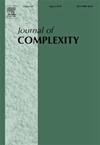Improved bounds for the bracketing number of orthants or revisiting an algorithm of Thiémard to compute bounds for the star discrepancy
IF 1.8
2区 数学
Q1 MATHEMATICS
引用次数: 0
Abstract
We improve the best known upper bound for the bracketing number of d-dimensional axis-parallel boxes anchored in 0 (or, put differently, of lower left orthants intersected with the d-dimensional unit cube ). More precisely, we provide a better estimate for the cardinality of an algorithmic bracketing cover construction due to Eric Thiémard, which forms the core of his algorithm to approximate the star discrepancy of arbitrary point sets from Thiémard (2001) [22]. Moreover, the new upper bound for the bracketing number of anchored axis-parallel boxes yields an improved upper estimate for the bracketing number of arbitrary axis-parallel boxes in . In our upper bounds all constants are fully explicit.
改进的正字括号数界限或重温蒂埃马计算星差界限的算法
我们改进了锚定在 0 的 d 维轴平行盒(或者换句话说,与 d 维单位立方体 [0,1]d 相交的左下正交)的已知括弧数上限。更确切地说,我们为埃里克-蒂埃玛尔(Eric Thiémard)提出的括号盖构造的心数提供了一个更好的估计,该构造构成了蒂埃玛尔(Thiémard)(2001)[22]中近似任意点集星形差异算法的核心。此外,锚定轴平行盒的括弧数的新上界可以改进[0,1]d 中任意轴平行盒的括弧数的上界估计。在我们的上界中,所有常数都是完全明确的。
本文章由计算机程序翻译,如有差异,请以英文原文为准。
求助全文
约1分钟内获得全文
求助全文
来源期刊

Journal of Complexity
工程技术-计算机:理论方法
CiteScore
3.10
自引率
17.60%
发文量
57
审稿时长
>12 weeks
期刊介绍:
The multidisciplinary Journal of Complexity publishes original research papers that contain substantial mathematical results on complexity as broadly conceived. Outstanding review papers will also be published. In the area of computational complexity, the focus is on complexity over the reals, with the emphasis on lower bounds and optimal algorithms. The Journal of Complexity also publishes articles that provide major new algorithms or make important progress on upper bounds. Other models of computation, such as the Turing machine model, are also of interest. Computational complexity results in a wide variety of areas are solicited.
Areas Include:
• Approximation theory
• Biomedical computing
• Compressed computing and sensing
• Computational finance
• Computational number theory
• Computational stochastics
• Control theory
• Cryptography
• Design of experiments
• Differential equations
• Discrete problems
• Distributed and parallel computation
• High and infinite-dimensional problems
• Information-based complexity
• Inverse and ill-posed problems
• Machine learning
• Markov chain Monte Carlo
• Monte Carlo and quasi-Monte Carlo
• Multivariate integration and approximation
• Noisy data
• Nonlinear and algebraic equations
• Numerical analysis
• Operator equations
• Optimization
• Quantum computing
• Scientific computation
• Tractability of multivariate problems
• Vision and image understanding.
 求助内容:
求助内容: 应助结果提醒方式:
应助结果提醒方式:


